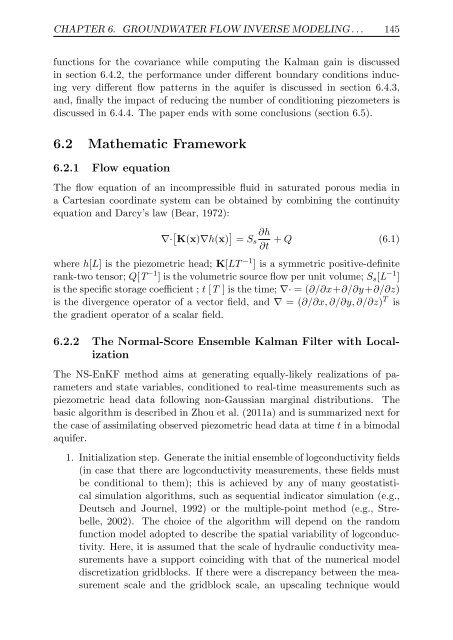Upscaling and Inverse Modeling of Groundwater Flow and Mass ...
Upscaling and Inverse Modeling of Groundwater Flow and Mass ...
Upscaling and Inverse Modeling of Groundwater Flow and Mass ...
Create successful ePaper yourself
Turn your PDF publications into a flip-book with our unique Google optimized e-Paper software.
CHAPTER 6. GROUNDWATER FLOW INVERSE MODELING . . . 145<br />
functions for the covariance while computing the Kalman gain is discussed<br />
in section 6.4.2, the performance under different boundary conditions inducing<br />
very different flow patterns in the aquifer is discussed in section 6.4.3,<br />
<strong>and</strong>, finally the impact <strong>of</strong> reducing the number <strong>of</strong> conditioning piezometers is<br />
discussed in 6.4.4. The paper ends with some conclusions (section 6.5).<br />
6.2 Mathematic Framework<br />
6.2.1 <strong>Flow</strong> equation<br />
The flow equation <strong>of</strong> an incompressible fluid in saturated porous media in<br />
a Cartesian coordinate system can be obtained by combining the continuity<br />
equation <strong>and</strong> Darcy’s law (Bear, 1972):<br />
∇· [ K(x)∇h(x) ] ∂h<br />
= Ss + Q (6.1)<br />
∂t<br />
where h[L] is the piezometric head; K[LT −1 ] is a symmetric positive-definite<br />
rank-two tensor; Q[T −1 ] is the volumetric source flow per unit volume; Ss[L −1 ]<br />
is the specific storage coefficient ; t [T ] is the time; ∇· = (∂/∂x+∂/∂y+∂/∂z)<br />
is the divergence operator <strong>of</strong> a vector field, <strong>and</strong> ∇ = (∂/∂x, ∂/∂y, ∂/∂z) T is<br />
the gradient operator <strong>of</strong> a scalar field.<br />
6.2.2 The Normal-Score Ensemble Kalman Filter with Localization<br />
The NS-EnKF method aims at generating equally-likely realizations <strong>of</strong> parameters<br />
<strong>and</strong> state variables, conditioned to real-time measurements such as<br />
piezometric head data following non-Gaussian marginal distributions. The<br />
basic algorithm is described in Zhou et al. (2011a) <strong>and</strong> is summarized next for<br />
the case <strong>of</strong> assimilating observed piezometric head data at time t in a bimodal<br />
aquifer.<br />
1. Initialization step. Generate the initial ensemble <strong>of</strong> logconductivity fields<br />
(in case that there are logconductivity measurements, these fields must<br />
be conditional to them); this is achieved by any <strong>of</strong> many geostatistical<br />
simulation algorithms, such as sequential indicator simulation (e.g.,<br />
Deutsch <strong>and</strong> Journel, 1992) or the multiple-point method (e.g., Strebelle,<br />
2002). The choice <strong>of</strong> the algorithm will depend on the r<strong>and</strong>om<br />
function model adopted to describe the spatial variability <strong>of</strong> logconductivity.<br />
Here, it is assumed that the scale <strong>of</strong> hydraulic conductivity measurements<br />
have a support coinciding with that <strong>of</strong> the numerical model<br />
discretization gridblocks. If there were a discrepancy between the measurement<br />
scale <strong>and</strong> the gridblock scale, an upscaling technique would


